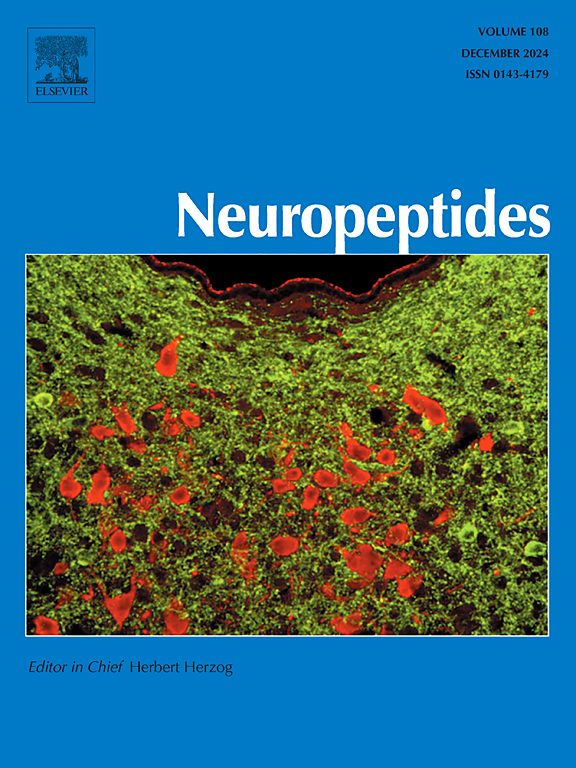Therapeutic potential of small peptides in Alzheimer's disease: Advances in memory restoration and targeted delivery systems
IF 2.7
3区 医学
Q3 ENDOCRINOLOGY & METABOLISM
引用次数: 0
Abstract
Despite extensive research into Alzheimer's disease (AD), few therapeutic strategies have successfully addressed its core pathology at the synaptic level. Small peptides represent a promising class of therapeutic agents capable of modulating key molecular pathways involved in amyloid toxicity, tau hyperphosphorylation, and synaptic degeneration. Their unique ability to cross biological barriers, interact with intracellular targets, and be modified for enhanced stability positions them as viable candidates for next-generation treatments targeting cognitive decline in AD.Small peptides show strong therapeutic potential yet face challenges in clinical application due to poor bioavailability and rapid enzymatic degradation. To deal with these limitations, various delivery strategies such as intranasal administration, nanoparticle encapsulation, and chemical modification have been developed. When combined with advanced delivery systems, small peptides hold significant promise for mitigating synaptic dysfunction and slowing the progression of Alzheimer's disease. In this review, we examine the mechanisms of action of four small peptides that demonstrate potential in alleviating Alzheimer's-related symptoms. We also evaluate the most effective delivery methods, emphasizing how these approaches enhance the peptides' therapeutic efficacy.
小肽在阿尔茨海默病中的治疗潜力:记忆恢复和靶向递送系统的进展
尽管对阿尔茨海默病(AD)进行了广泛的研究,但很少有治疗策略成功地在突触水平上解决其核心病理问题。小肽是一类很有前途的治疗药物,能够调节涉及淀粉样蛋白毒性、tau蛋白过度磷酸化和突触变性的关键分子途径。它们跨越生物屏障、与细胞内靶点相互作用以及通过修饰增强稳定性的独特能力,使它们成为针对AD认知能力下降的下一代治疗的可行候选药物。小肽具有很强的治疗潜力,但由于生物利用度差、酶降解快,在临床应用中面临挑战。为了解决这些限制,各种给药策略,如鼻内给药、纳米颗粒包封和化学修饰已经开发出来。当与先进的递送系统结合时,小肽在减轻突触功能障碍和减缓阿尔茨海默病的进展方面具有重要的前景。在这篇综述中,我们研究了四种具有缓解阿尔茨海默病相关症状潜力的小肽的作用机制。我们还评估了最有效的递送方法,强调这些方法如何增强肽的治疗效果。
本文章由计算机程序翻译,如有差异,请以英文原文为准。
求助全文
约1分钟内获得全文
求助全文
来源期刊

Neuropeptides
医学-内分泌学与代谢
CiteScore
5.40
自引率
6.90%
发文量
55
审稿时长
>12 weeks
期刊介绍:
The aim of Neuropeptides is the rapid publication of original research and review articles, dealing with the structure, distribution, actions and functions of peptides in the central and peripheral nervous systems. The explosion of research activity in this field has led to the identification of numerous naturally occurring endogenous peptides which act as neurotransmitters, neuromodulators, or trophic factors, to mediate nervous system functions. Increasing numbers of non-peptide ligands of neuropeptide receptors have been developed, which act as agonists or antagonists in peptidergic systems.
The journal provides a unique opportunity of integrating the many disciplines involved in all neuropeptide research. The journal publishes articles on all aspects of the neuropeptide field, with particular emphasis on gene regulation of peptide expression, peptide receptor subtypes, transgenic and knockout mice with mutations in genes for neuropeptides and peptide receptors, neuroanatomy, physiology, behaviour, neurotrophic factors, preclinical drug evaluation, clinical studies, and clinical trials.
 求助内容:
求助内容: 应助结果提醒方式:
应助结果提醒方式:


